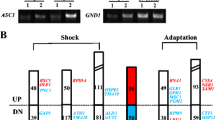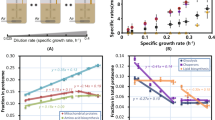Abstract
Transcriptome analyses using a wild-type strain of Saccharomyces cerevisiae were performed to assess the overall pattern of gene expression during the transition from glucose-based fermentative to glycerol-based respiratory growth. These experiments revealed a complex suite of metabolic and structural changes associated with the adaptation process. Alterations in gene expression leading to remodeling of various membrane transport systems and the cortical actin cytoskeleton were observed. Transition to respiratory growth was accompanied by alterations in transcript patterns demonstrating not only a general stress response, as seen in earlier studies, but also the oxidative and osmotic stress responses. In some contrast to earlier studies, these experiments identified modulation of expression for many genes specifying transcription factors during the transition to glycerol-based growth. Importantly and unexpectedly, an ordered series of changes was seen in transcript levels from genes encoding components of the TFIID, SAGA (Spt-Ada-Gcn5-Acetyltransferase), and SLIK (Saga LIKe) complexes and all three RNA polymerases, suggesting a modulation of structure for the basal transcriptional machinery during adaptation to respiratory growth. In concert with data given in earlier studies, the results presented here highlight important aspects of metabolic and other adaptations to respiratory growth in yeast that are common to utilization of multiple carbon sources. Importantly, they also identify aspects specific to adaptation of this organism to growth on glycerol as sole carbon source.


Similar content being viewed by others
References
Affymetrix (2000) Affymetrix GeneChip expression analysis technical manual. Santa Clara, CA
Backhus L, DeRisi J, Brown PO, Bisson L (2001) Functional genomic analysis of a commercial wine strain of Saccharomyces cerevisiae under differing nitrogen conditions. FEMS Yeast Res 1:111–125
Boorsma A, Bussemaker H (2005) T-Profiler; a web-tool to infer transcriptional module activity from gene expression data. Nucleic Acid Res 33:W592–W595
Brauer MJ, Saldanha AJ, Dolinski K, Botstein D (2005) Homeostatic adjustment and metabolic remodeling in glucose-limited yeast cultures. Mol Biol Cell 16:2503–2517
Carlson M (1999) Glucose repression in yeast. Curr Opin Microbiol 2:202–207
DeRisi JL, Iyer VR, Brown PO (1997) Exploring the metabolic and genetic control of gene expression on a genomic scale. Science 278:680–686
Ferreira C, van Voorst F, Martins A, Neves L, Oliveira R, Kielland-Brandt MC, Lucas C, Brandt A (2005) A member of the sugar transporter family, Stl1p is the glycerol/H+ symporter in Saccharomyces cerevisiae. Mol Biol Cell 16:2068–2076
Gancedo JM (1998) Yeast carbon catabolite repression. Microbiol Mol Biol Rev 62:334–361
Gasch AP, Spellman PT, Kao CM, Carmel-Harel O, Eisen MB, Storz G, Botstein D, Brown PO (2000) Genomic expression programs in the response of yeast cells to environmental changes. Mol Biol Cell 11:4241–4257
Jazwinski SM (2005) The retrograde response links metabolism with stress responses, chromatin-dependent gene activation, and genome stability in yeast aging. Gene 354:22–27
Larsson C, Pahlman IL, Ansell R, Rigoulet M, Adler L, Gustafsson L (1998) The importance of the glycerol-3-phosphate shuttle during aerobic growth of Saccharomyces cerevisiae. Yeast 14:347–357
Lu L, Roberts GR, Oszust C, Hudson AP (2005) The YJR127C/ZMS1 gene product is involved in glycerol-based respiratory growth of the yeast Saccharomyces cerevisiae. Curr Genet 48:235–246
McEntee CM, Hudson AP (1989) Preparation of RNA from unspheroplasted yeast cells (Saccharomyces cerevisiae). Anal Biochem 176:303–306
Ohlmeier S, Kastaniotis J, Hiltunen JK, Bergmann U (2004) The yeast mitochondrial proteome, a study of fermentative and respiratory growth 279:3956–3979
Pavlik P, Simon M, Schuster T, Ruis H (1993) The glycerol kinase (GUT1) gene of Saccharomyces cerevisiae: cloning and characterization. Curr Genet 24:21–25
Rønnow B and Kielland-Brandt MC (1993) GUT2, a gene for mitochondrial glycerol 3-phosphate dehydrogenase of Saccharomyces cerevisiae. Yeast 9:1121–1130
Rep M, Krantz M, Thevelein JM, Hohmann S (2000) The transcriptional response of Saccharomyces cerevisiae to osmotic shock. Hot1p and Msn2p/Msn4p are required for the induction of subsets of high osmolarity glycerol pathway-dependent genes. J Biol Chem 275:8290–8300
Rolland F, Winderickx J, Thevelein JM (2002) Glucose-sensing and -signaling mechanisms in yeast. FEMS Yeast Res 2:185–201
Sambrook D, Russell DW (eds) (2001) Molecular cloning: a laboratory manual. CSHL Press, Cold Spring Harbor, New York, pp 7.31–7.34
Schüller HJ (2003) Transcriptional control of nonfermentative metabolism in the yeast Saccharomyces cerevisiae. Curr Genet 43:139–160
Sherman F (2002) Getting started with yeast. In: Guthrie C, Fink GR (eds) Guide to yeast genetics and molecular biology. Meth Enzymol, vol 350. Academic Press, San Diego, pp 3–41
ter Linde JJ, Liang H, Davis W, Steensma HY, van Dijken JP, Pronk JT (1999) Genome-wide transcriptional analysis of aerobic and anaerobic chemostat cultures of Saccharomyces cerevisiae. J Bacteriol 181:7409–7413
Uesono Y, Ashe M, Toh-e A (2004) Simultaneous yet independent regulation of actin cytoskeletal organization and translation initiation by glucose in Saccharomyces cerevisiae. Mol Biol Cell 15:1544–1556
Valadi A, Granath K, Gustafsson L, Adler L (2004) Distinct intracellular localization of Gpd1p and Gpd2p, the two yeast isoforms of NAD+-dependent glycerol-3-phosphate dehydrogenase, explains their different contributions to redox-driven glycerol production. J Biol Chem 279:39677–39685
Zakrzewska A, Boorsma A, Brul S, Hellingwerf KJ, Klis F (2005) Transcriptional response of Saccharomyces cerevisiae to the plasma membrane-perturbing compound chitosan. Eukar Cell 4:703–715
Acknowledgments
This work was supported by a grant from Department of Veterans Affairs Medical Research Service to APH. We are grateful to Prof. Craig N. Giroux (Wayne State University) for many helpful discussions. We also thank Annette Thelen of the Michigan State University Genomics Technology Support Facility for her expert assistance in performing the RNA fragmentation, microarray hybridizations, and flagging expression values with MAS 5.0.
Author information
Authors and Affiliations
Corresponding author
Additional information
Communicated by S. Hohmann
Rights and permissions
About this article
Cite this article
Roberts, G.G., Hudson, A.P. Transcriptome profiling of Saccharomyces cerevisiae during a transition from fermentative to glycerol-based respiratory growth reveals extensive metabolic and structural remodeling. Mol Genet Genomics 276, 170–186 (2006). https://doi.org/10.1007/s00438-006-0133-9
Received:
Accepted:
Published:
Issue Date:
DOI: https://doi.org/10.1007/s00438-006-0133-9




